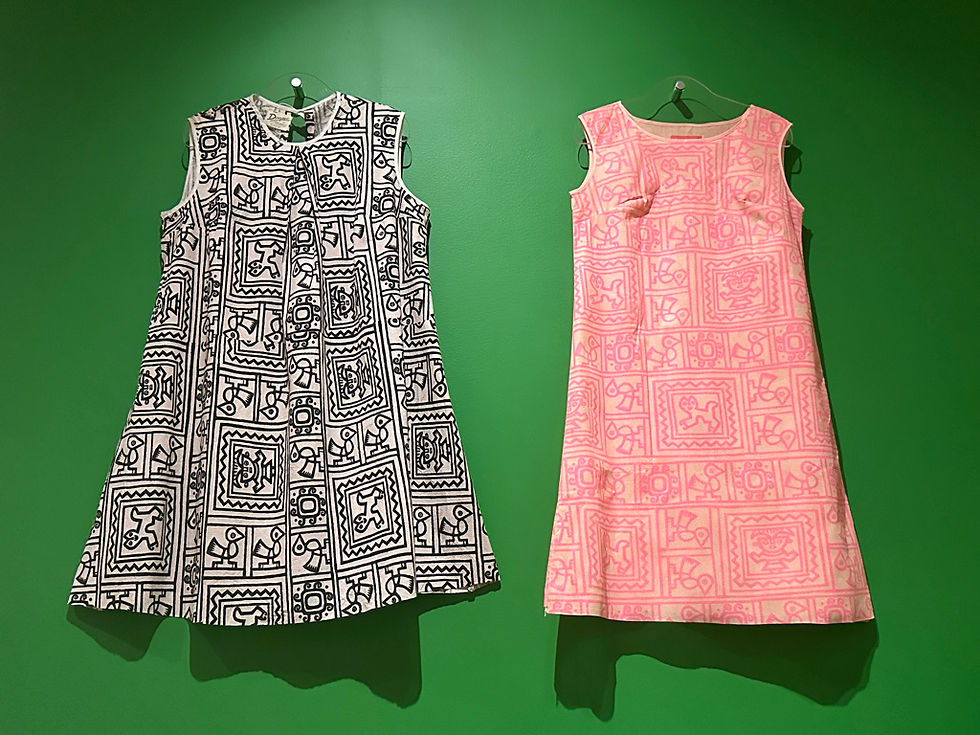Paper Dresses, but not for Paper Dolls!
- Thea Hwang
- Jan 1, 2024
- 3 min read
Updated: Feb 1, 2024

At the end of summer 2023, I went to the Generation Paper: A Fashion Phenom of the 1960s exhibit at the Museum of Arts and Design in New York City. Generation Paper explored a fashion trend in the 1960s for garments made from “paper”!
Despite being called “paper” dresses, the “paper” label was really due to the fact that this trend was started by the Scott Paper Company, which we still know today as a brand for bath tissue products. The “paper” garments were actually made out of rayon, polyester, other synthetic fibers, polyethylene, and even (to be rainproof) laminated plastics and metallics. Among the different paper-like fabrics were: Dura-Weve, which felt like paper towels; Kaycel, with a hospital gown-feel; ReemayⓇ, dryer sheet-like; and Metalized KyronⓇ, which was similar in touch to Tyvec.
The disposable dress designs had bold and graphic styles and were sold in the United States and the United Kingdom in a variety of ways, from boutiques and department stores to drugstores and catalogs. With their space-age aesthetics, the new non-woven textiles had a youthful appeal. In the end though, this fun, ultra-modern look could not overcome the practical challenges of comfort, durability, flammability, and sustainability, leading to its short-lived moment in mainstream fashion. The “paper” dress fad ended by 1970, but left behind some long-term impacts. These 1960s "paper" fabric innovations and experimentations evolved into the health and safety personal protective equipment still used today.
Although their manufacturers claimed that “paper” clothing was environmentally friendly since they did not need to be washed, these garments were not easily recyclable and often ended up in landfills. This is perhaps an early example of a claim of environmentalism being debunked by later emerging eco-considerations.

Pics & Captions
The Scott Paper Company kicked-off the "paper" dress fad by introducing “paper” dresses at the televised 1966 Junior Miss Pageant. For a small fee, customers could select between the two bold prints shown on the left and receive a "Paper Caper" Dura-Weve dress. Dura-Weve was a new disposable textile intended for use in home goods and tableware.

The James Sterling Paper Company created "paper" wrap dresses, jumpsuits, minidresses, inexpensive bridal gowns, and maternity dresses. One of its most popular prints is the near-right 3-piece ensemble shown in the picture on the right.

Airline companies created "paper" flight-attendant uniforms that could be worn and discarded after each flight. Companies promoted new international routes by featuring festive "paper" uniforms (such as the one on the near-left of this picture) worn by flight attendants during in-flight service. While decorative and fun, the "paper" uniforms were reported to be uncomfortable and impractical while on the job.
On the far-left of the same picture is a design by Elisa Daggs, who was commissioned by Trans World Airlines to design this metallic gold uniform worn by flight attendants in first class on New York to Paris flights. Daggs treated the disposable material like traditional fabric, including belts and belt loops, collars, ruffles, sleeve cuffs, and functioning pockets in her designs. Dagg's designs were tailored and sold for a higher price than the typical ready-to-wear, low-cost "paper" ensemble, which often consisted of just two sides and two shoulder seams.


The simple design and flat surface of A-line "paper" dresses made them highly impactful as marketing devices, a precursor to promotional T-shirts. Many companies (and even some political candidates) recognized the "walking billboard" potential of the "paper" dress, including the Campbell Soup Company and Butterfinger.




Comments